Circuit Maesters
An adventure towards developing the first self-driving vehicle of Bangladesh
Visit WebsiteOverview
- Started: January, 2021
- Project Status: Ongoing
- Estimated Completion By: June, 2023
Problem Statement
Bangladesh lags significantly behind in the R&D of self-driving vehicles, which is largely due to the inadequate investment in AI technologies, lack of access to necessary datasets, and a shortage of skilled professionals in this field. This technological gap is concerning since self-driving vehicles have the potential to revolutionize transport, reducing congestion and accidents, and promoting sustainability.
Solution
It is therefore crucial for young engineering students from our country to focus on the research of self-driving vehicle, as they will play a vital role in building the dataset curated to the exceptional traffic situations arise on our roads and also improve the existing algorithms. The availability and caliber of local datasets will have a significant impact on the development of autonomous car technology that is Bangladesh-Road-Ready. As such, these students should be encouraged to gather and work with data relevant to the unique road conditions and traffic behaviors in their regions. This way, they can contribute to the development of AI systems that can safely navigate the complex driving environments of the Indian subcontinent.
Circuit Maesters was founded in the aim to develop the country's first self-driving vehicle (a much simpler version in terms of features and engineering, than the industry grade self-driving vehicles that are available at consumer level). The primary goal was to inspire local university-level engineering students to further research and contribute in this field.
Objectives
Build a self-driving formula style vehicle (Level-4 autonomy)
Participate at Formula Student UK (Artificial Intelligence Segment)
Establish a community for future students to research and work with self-driving vehicle
My contributions
Entrepreneurship
Tech/Engineering
Design/Branding
Reference Projects
Build a self-driving formula style vehicle (Level-4 autonomy)
Participate at Formula Student UK (Artificial Intelligence Segment)
Establish a community for future students to research and work with self-driving vehicle

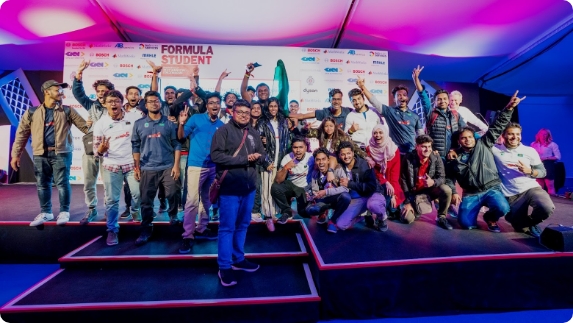
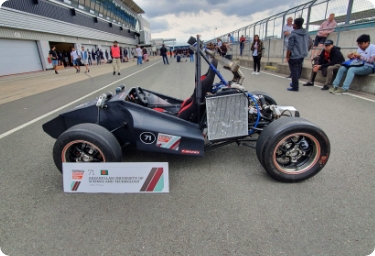
How it all started?
It all started back in August 2019, after I returned with Team Primus from Formula Student UK 2019 event. During my amazing experience at the event, I had the opportunity to visit the exhibitions from other teams. Teams from different universities from all around the world. I was very fascinated by the self-driving vehicles that I had seen which were designed by my peers from first world countries, but the most interesting fact to me about them was, they all looked 'achievable' to me.
I have my talented childhood friends working with me at BiTechX, who have prior experience in machine learning based development, I have already gained experience building a formula style vehicle with Team Primus, and I am already in my 5th semester of undergrad in Electrical & Electronic Engineering (EEE) so I have the electrical/electronic aspect of the vehicle covered as well. So what's stopping me from founding a team and starting to grind?
I proposed this idea to a few of my classmates in EEE including some of former Team Primus teammates, and invited them to join me in this venture. My initial criteria to select founding members was to find qualities that can drive the team towards successfully achieving all goals. I also invited my friends from another university (University of Dhaka ), to join us since they had better prospects at managing the AI team than others.
After setting up a founding team, I drafted a proposal including roadmap and organized a project proposal presentation inviting all the senior faculty members of EEE. Later, I approached Prof. Dr. Ehtesanul Islam (head of EEE at that time) and Prof. Dr. Omar Farrok too with an invitation to become our supervisor and 2nd-supervisor respectively, since they had the capacity to provide us with most necessary resources.
Most of our last quarter of 2019 and first quarter of 2020 was spent building the perfect team, and raising funds to purchase initial components. In the beginning of 2020, when we had already recruited about 30 engineering students from five disciplines and two universities, I with the help of our supervisor approached our Vice Chancellor for funding and logistic help from the university. The roadmap was designed to build the vehicle by the beginning of 2021 and participate at the Formula Student UK AI 2021 event in July, 2021. By March 2020, the team had raised about 6.5 lacs BDT (about 6,200 USD as of 2023) from student members and also secured university's assistance in logistics and funding throughout the journey.
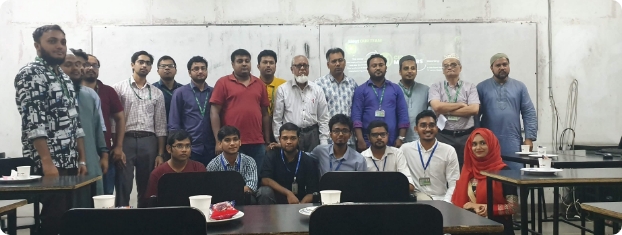
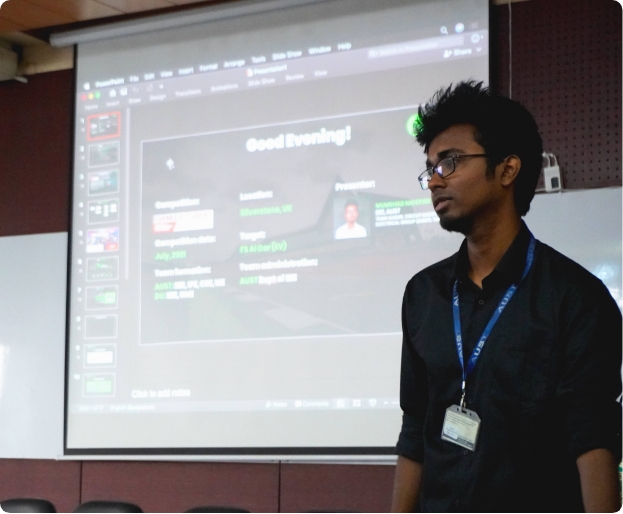
2
universities
2
supervisors
30
students
5
faculty
1
team
To ensure dedicated research and focused group work, as the leader of the team, I divided the 30-student team into five groups, each having its own group leader. Group leaders were responsible for delegating the research and design tasks to their group members and communicate between the groups to ensure design compatibility.
The teams are (sorted by roadmap flow):
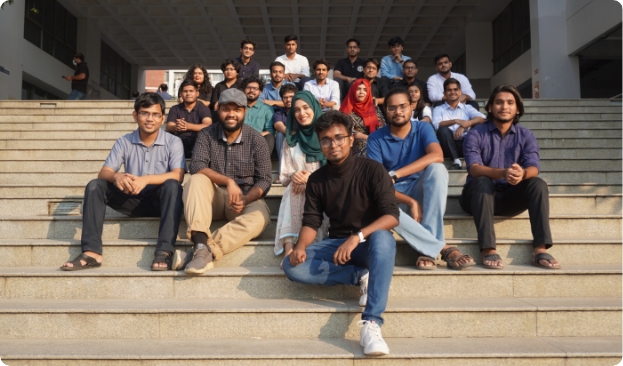

1. Business Logic Case Group
Group Leader: Maham Ahmad (Industrial & Production Engineering, Ahsanullah University of Science & Technology)
Responsible for sourcing the materials, cost calculation, marketing, recruitment and other business aspects of the team.
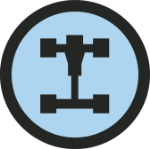
2. Chassis Design & Fabrication Group
Group Leader: Hossain M Yousuf (Mechanical Engineering, Ahsanullah University of Science & Technology)
Responsible for suspension design, vehicle geometry design, chassis design/fabrication, etc.

3. Power System Group
Group Leader: Md. Amanat Hossain (Electrical & Electronic Engineering, Ahsanullah University of Science & Technology)
Responsible for designing the power accumulator, electric drivetrain and other high voltage peripherals.

4. Electronic System Group
Group Leader: Tasnemul Hasan Nehal (Electrical & Electronic Engineering, Ahsanullah University of Science & Technology)
Responsible for designing the integrated circuits, CAN-bus, control system, and other low voltage peripherals.

5. Artificial Intelligence Group
Group Leader: Raiyaan Abdullah (Robotics & Mechatronics Engineering, Dhaka University)
Responsible for designing the perception, localization and motion planning software infrastructure of the vehicle.
Due to the Covid-19 pandemic, logistical complexity, and funding delays, the team could not achieve its first target to build the vehicle by 2021. Then later after re-evaluating the current assets and opportunities, the team has restarted and aimed to finish building the vehicle by the year 2023.
how it's going
Team Achievements
Completed designs of chassis, electronic system and power system.
Prepared (including annotations) 3000+ images of traffic cones following FSAE guidelines for vehicle perception AI model training purpose.
Raised total 16 lacs BDT ($15,000+ USD) from the university and 20 lacs BDT ($18,000+ USD) from the student members, and purchased most of the components as of May 2023.
Inspired faculty members to form more electric and self-driving vehicle R&D groups, and future students to research and work with self-driving vehicle in their final year thesis.
Fifficulties Faced Till Date
Lack of short-term goals demotivated a lot of student members after a while, which resulted in mass resignation and vacancies.
Estimated budget ramped up multiple times due to unforeseen pandemic, recessions and Ukraine war, resulting in components going out of stock, logistical complexities/delays, and shortage of fund.
Graduating members leaving the team and lack of energetic and fast-learner recruits resulting in project delay.

The engineering objectives of the vehicle
The Formula Student UK has some specific guidelines for the vehicle design that needed to be followed by the teams. The competition also have some objectives to be completed by the vehicle. Unlike the self-driving vehicles we see on roads made by giant companies like Tesla, Waymo, Uber, etc, the FSAE driverless vehicle has much simpler objectives that undergrad level students can easily achieve.
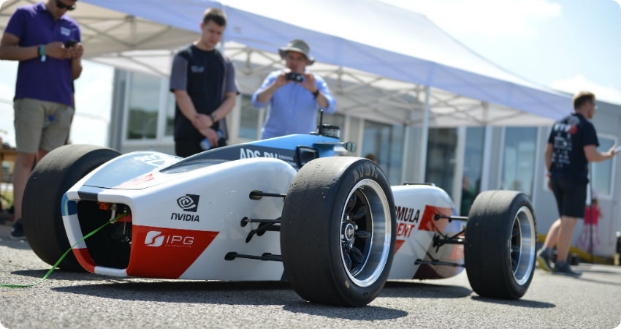
Engineering (static event)
Vehicle frame and chassis need to be compliant with all the safety and design guidelines provided by FSAE.
Vehicle needs to be able to operate in full autonomy, no human assistance allowed after it starts running on track.
Vehicle needs to do local and real time processing based on the perception and localization data achieved through exteroceptive sensors, no prior track data can be fed to the software or no hard-code allowed.
Motorsport (dynamic event)
Vehicle needs to autonomously run multiple laps on a track involving sharp turns. Tracks are defined by blue and yellow cones (completing the track in shortest time achieves maximum points)
Vehicle needs to complete an auto-sprint (top speed achieves max points)
Vehicle needs to go through straight track (top acceleration achieves max points)
How I planned to approach
It might sound hilarious but, in my mind I have considered this as just a giant line follower robot, since a lot of the objectives are somewhat similar to what I did with my line follower robots in my earlier undergrad life, and just went with it. Line followers included:
- Sound-based sensors (ex: sonar) to measure distance
- Laser-based sensors (ex: IR sensor) to detect color of the lines
- 12V DC batteries
- Arduino
- 12V DC geared motors
Now a human sized one-seater car cannot be operated by 12V DC motors. It needs a much bigger motor that is:
- capable of generating sufficient torque to move about 500 kg (estimated 300kg for the vehicle, 200 kg for human)
- compact enough